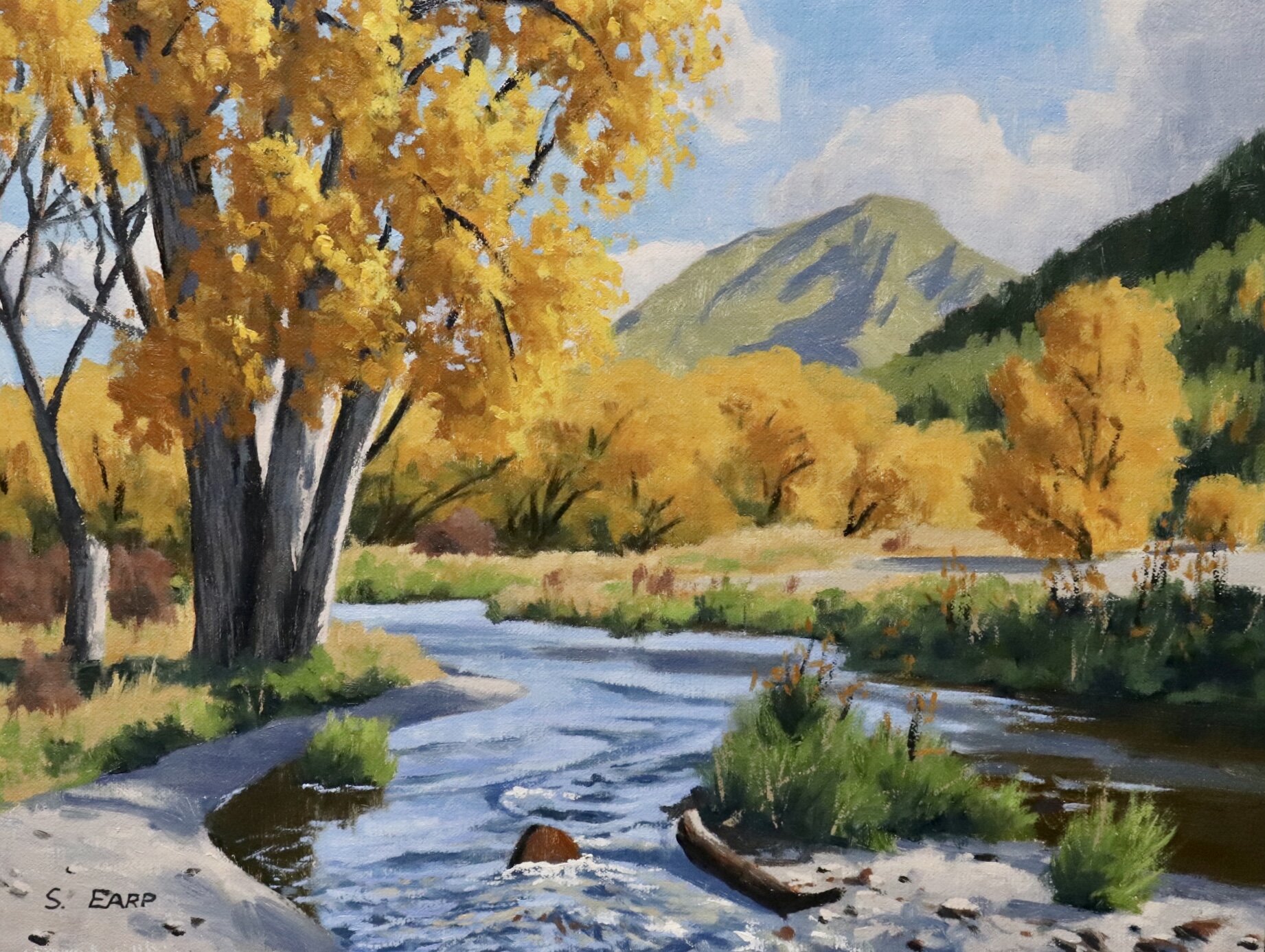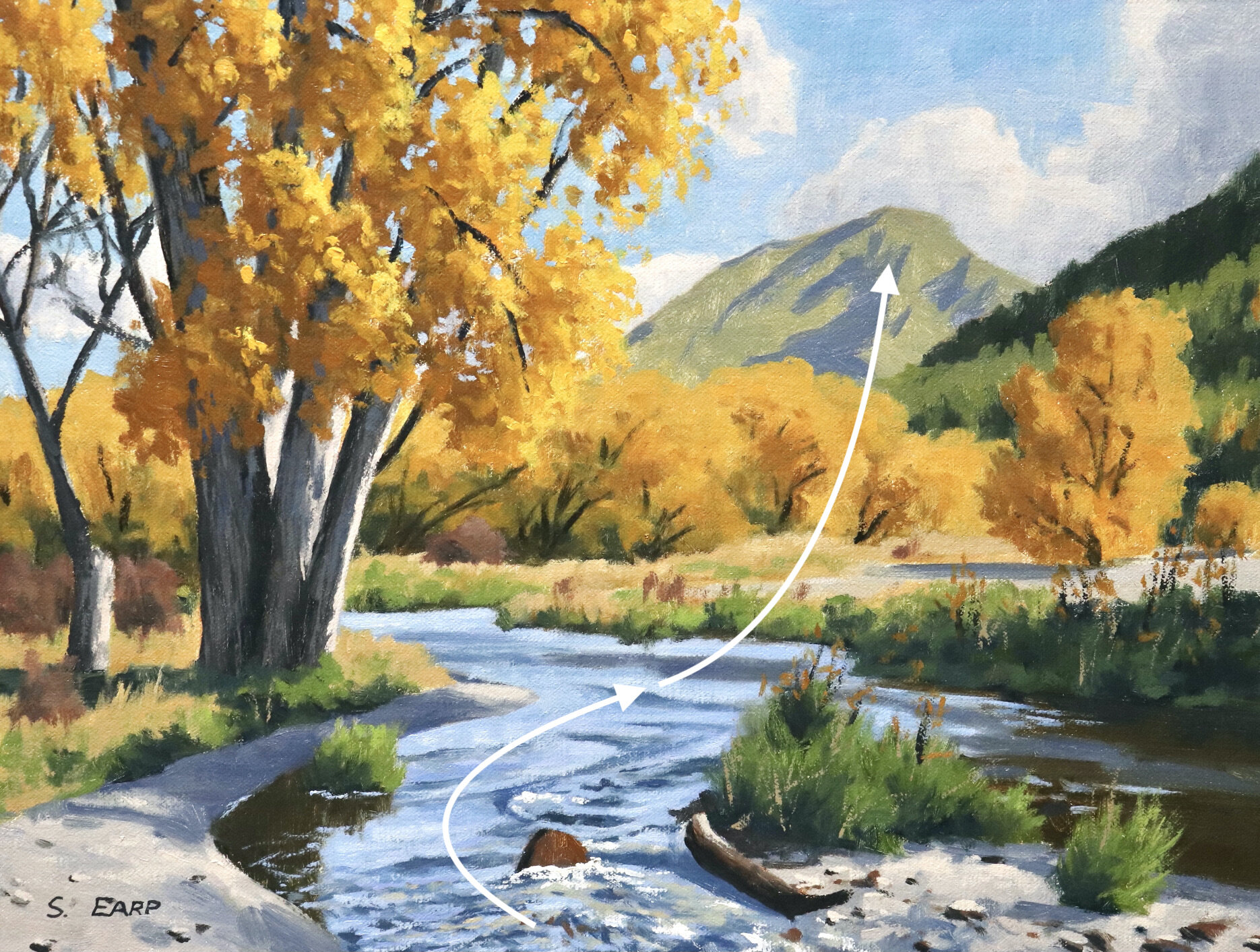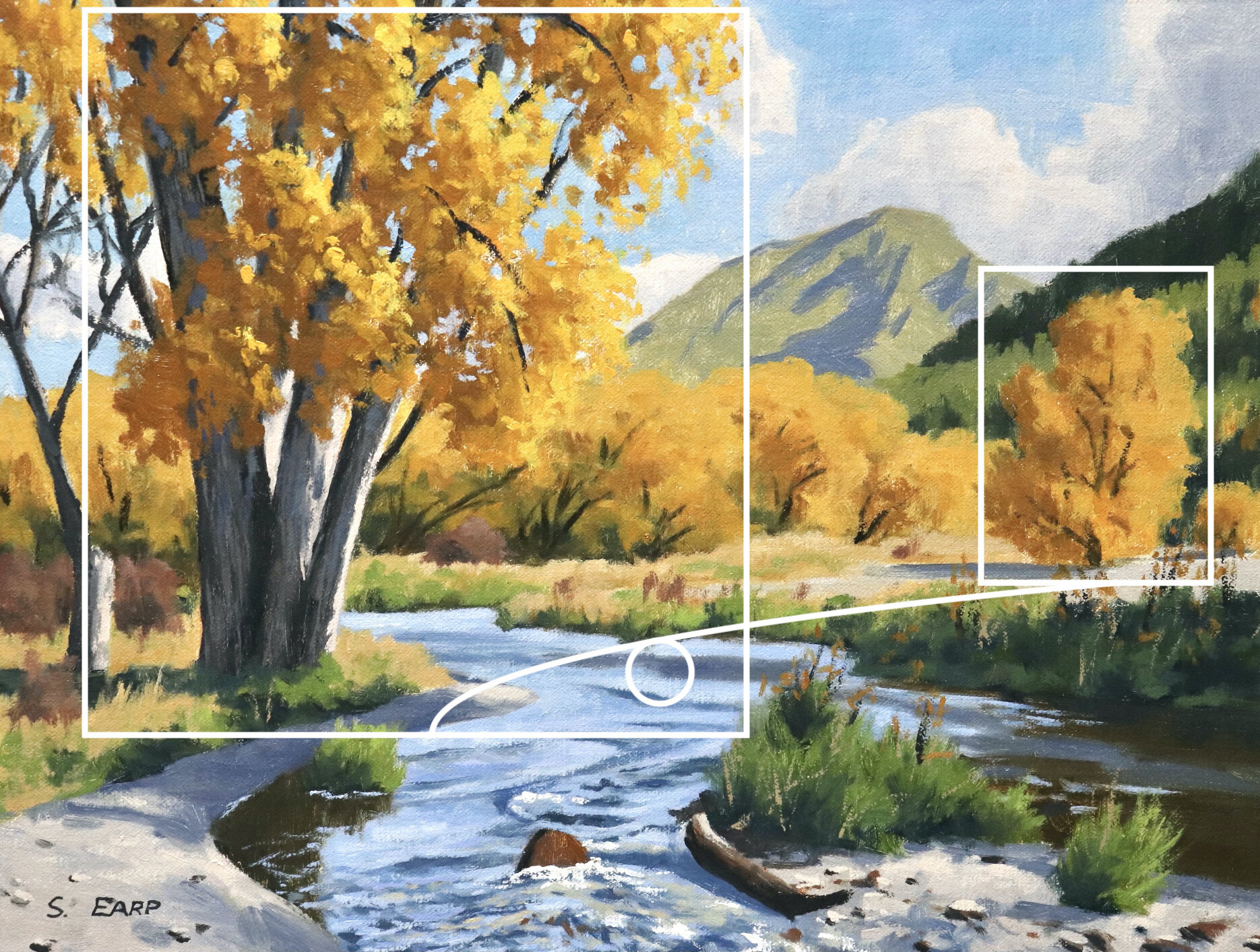
In this blog post I will demonstrate how to paint an autumn / fall themed landscape that features broadleaf deciduous trees exhibiting golden yellow autumn colours. This painting is inspired by a place called Arrowtown in southern New Zealand. It was historically planted with European trees which display beautiful colours in autumn.
Suitable for oils and acrylics.
Reference Photos
Here are a couple of reference photos I took and used in this painting. Please feel free to use or copy these photos if you would like to have a go at painting this art work.


Composition
In general I try and keep my compositions relatively simple going by the principle that less is more, however there are a couple of things going on in this composition. One of the main things I have tried to convey in this painting is flow and rhythm and having an element that directs the eye towards a focal point such as a river, waterway, path or road will help to achieve this.
In this painting the stream leads the eye towards the hill in the background.

Balance
The large poplar is one of the main areas of interest in the painting and is also the largest mass. I have loosely incorporated a ‘steelyard’ composition in this painting which helps to communicate balance. The large poplar tree in the foreground is counterbalanced by the smaller poplar in the mid ground on the right side of the painting.

Colours
I painted this artwork using oil paint and the colours I used in this painting are as follows:
- Titanium white
- Burnt sienna
- Yellow ochre
- Cadmium yellow
- Cadmium orange
- Alizarin crimson
- Ultramarine blue
- Phthalo green
Brushes
Here is a list of the brushes I used in this painting:
- No.5 flat
- No.3 flat
- No.2 flat
- No.3 filbert
- No.0 round
Painting Demonstration
Stage 1 – Blocking in the Painting
I am painting on an 12” x 16” linen panel. The panel is pre made with a medium weave linen that is oil primed.
I sketch the composition using a No.1 round brush with burnt sienna mixed with Liquin Original (Liquin). I am using Liquin as a medium to thin the paint and it also has the advantage of speeding up the drying time.

I begin by painting the dark values and shadows first, starting with the tree stems and then the shadows in the hill and the clouds. All three zones are a mix of ultramarine blue, burnt sienna, titanium white and a small amount of alizarin crimson. For the tree stems in the foreground I have used a very small amount of titanium white in the mix but I have used much more for the hill and clouds as these shadows get much lighter in value.
The shadows in the grass, plants and trees in the foreground and mid ground are a mix of ultramarine blue and yellow ochre. I have also added a little titanium white to the mix for the trees in the mid ground.
I always aim for colour harmony in my art works and this is achieved by using common colours throughout the painting.

I start painting the shadows in the foliage of the trees. Yellow is a light value colour so the shadows in these leaves are going to be lighter in value than some of the other elements in the painting such as the tree stems and the shadows in the forest on the hill.
The shadows in the tree canopies are a mix of yellow ochre, alizarin crimson and ultramarine blue.
For the foliage of the poplar tree that is in the full sun light I have used a mix of yellow ochre, cadmium yellow, cadmium orange and titanium white.

I paint the sky and clouds and I am going to use the sky to paint the negative spaces around the poplar tree canopy which will help to build up the tree’s form.
The sky is a simple mix of ultramarine blue, titanium white and a little phthalo green. I also paint the highlights of the clouds which is a mix of titanium white and a little burnt sienna.
I paint the canopies of the willow trees in the mid ground using a mix of yellow ochre, cadmium yellow, cadmium orange and titanium white. I have used a little more titanium white and yellow ochre in the mix compared with the poplar in the foreground. This desaturates the colour a little as well as making the value lighter.

I paint the background hill with a mix of ultramarine blue, yellow ochre, alizarin crimson and titanium white. I have created a low chroma green here so the hill sits back in the landscape.
I use the same colours for the conifer trees on the hill in the mid ground. I have also added a little phthalo green in the mix to increase the saturation.
The straw coloured grass in the foreground is a low chroma light value colour which I mixed using yellow ochre, burnt sienna, titanium white and a little ultramarine blue.

I finish the blocking-in stage of this painting by painting the stream in the foreground and the banks at the side of the stream. The stream is reflecting the sky so I am mostly using a mix of ultramarine blue, a little phthalo green and titanium white. For the darker areas in the ripples I have used a mix of ultramarine blue, yellow ochre and titanium white.
I paint the grass in the foreground with a mix of yellow ochre, cadmium yellow, ultramarine blue and titanium white. I also mix in a little cadmium orange in places to make the green look more natural.
I always try and get as much information down as I can during the blocking-in stage and making sure that the colours, values and tonal dynamic is working. When I am happy with this I let the whole painting dry so I can add details to it.

Stage 2 – Adding Details
Now that the painting is dry and I can add details and build up some layers within the painting. I am pretty much using the same colours I used during the blocking-in stage but building up details and lighter layers of paint.
The main zone I worked on during this particular session on my painting was the foliage in the trees. I have increased the saturation of the colours by using more cadmium yellow in my mix. I used the same colours for the leaves in the poplar tree as I did during the blocking in stage and I apply the paint using a No.3 filbert brush.
I paint the suggestions of stems in the willow trees in the mid ground.

At this point in the painting I am getting closer to finishing it and so I am adding finer details to the trees, plants and water in the foreground.
I paint the suggestion of branches and twigs in the foreground poplar trees using a mix of ultramarine blue and burnt sienna.
I add some more lighter layers of paint to the tree foliage of the poplar trees again using a mix of yellow ochre, cadmium yellow, cadmium orange and titanium white.

Stage 3 – Adding Final Details
I complete the painting by adding the lightest values in the scene, mainly in the tree foliage where I add sparingly some highlights in the leaves. There are also some highlights in the water that is reflecting the bright sunlight.
I added some bushes in the mid ground to break up the line of the willow trees a little and I finish up the painting by adding small details such as suggestion of plants, blades of grass and stones in the foreground.

Thanks for reading 😊
